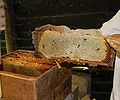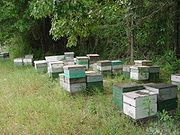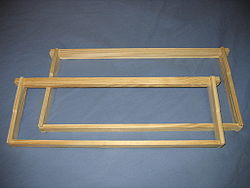
Langstroth hive
Encyclopedia


Beehive (beekeeping)
A beehive is an enclosed structure in which some honey bee species of the subgenus Apis live and raise their young. Natural beehives are naturally occurring structures occupied by honeybee colonies, while domesticated honeybees live in man-made beehives, often in an apiary. These man-made...
used in many parts of the world for beekeeping
Beekeeping
Beekeeping is the maintenance of honey bee colonies, commonly in hives, by humans. A beekeeper keeps bees in order to collect honey and other products of the hive , to pollinate crops, or to produce bees for sale to other beekeepers...
. The advantage of this hive is that the bees build honeycomb into frames, which can be moved with ease. The frames are designed to prevent bees from attaching honeycombs where they would either connect adjacent frames, or connect frames to the walls of the hive. The movable frames allow the beekeeper to manage the bees in a way which was formerly impossible.
Other inventors, notably François Huber
François Huber
François Huber was a Swiss naturalist.He was born at Geneva, of a family which had already made its mark in the literary and scientific world: his great-aunt, Marie Huber, was known as a voluminous writer on religious and theological subjects, and as the translator and epitomizer of The Spectator...
in 1789, had designed hives with frames (the so-called leafe or book hive), but Langstroth's hive was a practical movable frame hive, which overcame the tendency of the bees to fill empty spaces with comb and to cement smaller spaces together with propolis. In contrast to August von Berlepsch's frame-movable side-opened hive (May 1852, Germany), Langstroth's hive was top-opened, as was the Bevan top-bar hive (1848, UK). These combined adaptations led to the Langstroth hive design being preferred by beekeepers over all others, and his hive is currently use throughout the world.
History
In 1851, the Reverend Lorenzo Lorraine Langstroth (1810-1895), a native of Philadelphia, noted that when his bees had less than 1 cm (3/8 inch) of space available in which to move around, they would neither build comb into that space nor cement it closed with propolisPropolis
Propolis is a resinous mixture that honey bees collect from tree buds, sap flows, or other botanical sources. It is used as a sealant for unwanted open spaces in the hive. Propolis is used for small gaps , while larger spaces are usually filled with beeswax. Its color varies depending on its...
. This measurement is presently called "bee space". During the summer of 1851, Langstroth applied the concept to keeping the lid free on a top-bar hive, but in autumn of the same year, he realized that the "bee space" could be applied to a newly-designed frame which would prevent the bees from attaching honeycomb to the inside of the hive box. This attachment of comb to the hive wall was a difficulty with frameless designs, such as Dzierżon's frameless movable-comb hive (1835). US Patent
Patent
A patent is a form of intellectual property. It consists of a set of exclusive rights granted by a sovereign state to an inventor or their assignee for a limited period of time in exchange for the public disclosure of an invention....
9300 was issued to Langstroth on October 25, 1852, and remained valid despite numerous attempts to challenge it based on its alleged use of prior art
Prior art
Prior art , in most systems of patent law, constitutes all information that has been made available to the public in any form before a given date that might be relevant to a patent's claims of originality...
.
Rev. Langstroth subsequently published a book called A Practical Treatise on the Hive and Honey-Bee, nowadays commonly known as The Hive and the Honey Bee or, under the title with which it was recently (2004) re-issued, as Langstroth's Hive and the Honey-Bee: The Classic Beekeeper's Manual. In this book, Langstroth described the proper dimensions and use of the modern beehive as we know it today. Prior to discovery of the dimensions of "bee space", bees were mostly hived in skeps (conical straw baskets) or gums (hollowed-out logs which approximated the natural dwellings of bees), or in box hives (a thin-walled wooden box with no internal structure).
In Europe
Dr. Jan DzierżonJan Dzierzon
Johann Dzierzon, in Polish Jan Dzierżon or Dzierżoń , also John Dzierzon , was a pioneering apiarist who discovered the phenomenon of parthenogenesis in bees and designed the first successful movable-frame beehive.Dzierzon came from a Polish family in Silesia...
, an apiarist (and, at the time, a Roman Catholic priest), had in the year 1835 determined the correct spacing for the top-bars in beehives. The distance between combs had been described as 1½ inches (38.1 mm) from the center of one top-bar to the center of the next one. In this case, the distance between combs is 1/2 inch (12.7 mm); that is, twice the minimum "bee space" of 1/4 inch (6.35 mm). This setup had been established for the brood chamber, as for honey storage the comb distance can be different.
Later, in 1848, Dzierżon introduced grooves into his hives' side walls, to replace the strips of wood that the top-bars had earlier been hung from. The grooves were 8 x 8 mm — a dimension intermediate between between 1/4 and 3/8 inch, the lower and upper limits of "bee space" as currently understood. Currently, 3/8 inch (6.35 – 9.53 mm) is the usual size meant when "bee space" is referred to.
In Europe, both Dzierżon and fellow apiarist Baron August von Berlepsch had been focused on side-opened hives. Land resources for beekeeping was limited, and traditionally multiple bee hives had been kept in a single beehouse. The so-called "bee space" had been incorporated by Berlepsch into his frame arrangement (Bienen-Zeitung, May 1852) following Dzierżon's discovery that grooves added to inner walls remained free of propolis (1848). Thus, the correct distance between frame side-bar and hive wall was already understood by some European beekeepers prior to 1851.
In America
L.L. Langstroth's patent of 5 October 1852 adopted 3/8 inch (9.53 mm) between the side bars of a frame and hive wall, and also reserved rights to use the distance 1/2 inch (12.7 mm) between top-bars and inner cover, the latter of which represents a gap larger than optimal.The term "bee space" was coined later than Langstroth's 1852 patent. Occasionally incorrect definitions are ascribed to "bee space". Term easily confused with "bee space" include: inter-comb space, 1/2 inch (12.7 mm); the distance from frame to hive wall, 1/4 to 3/8 inch (6.35 to 9.53 mm); and even the distance from frame to hive bottom, which can be as little as 1/4 inch but ranges to as much as 3/4 inch (6.35 to 19.05 mm).
L.L. Langstroth may have been aware of Dzierżon's discoveries prior to submitting his patent application. In the summer of 1851, he was introduced to Dzierżon's work by Samuel Wagner, who had translated it from the German language original. Wagner later founded the American Bee Journal. Moreover, Samuel Wagner visited Jan Dzierżon in his apiaries in Silesia
Silesia
Silesia is a historical region of Central Europe located mostly in Poland, with smaller parts also in the Czech Republic, and Germany.Silesia is rich in mineral and natural resources, and includes several important industrial areas. Silesia's largest city and historical capital is Wrocław...
(presently Poland
Poland
Poland , officially the Republic of Poland , is a country in Central Europe bordered by Germany to the west; the Czech Republic and Slovakia to the south; Ukraine, Belarus and Lithuania to the east; and the Baltic Sea and Kaliningrad Oblast, a Russian exclave, to the north...
). Wagner also subscribed to Bienen-Zeitung, the journal in which Dzierżon published his apiarian works. Wagner's translation of Theorie und Praxis, ... was never published; instead, Langstroth published his A Practical Treatise on the Hive and Honey-Bee.
Langstroth expressed great respect for Jan Dzierżon:
Langstroth constructed his hives so that the frames, in which the bees were to make their combs, could easily be separated from all adjacent parts of the hive — the walls of the hive, the floor of the hive, the cover of the hive, and other frames within the hive. To extract a frame from such a hive will not require any comb to be cut. Usually the most trouble a beekeeper encounters in removing a frame from such a hive results from the bees using propolis to bond frames to the brackets they rest upon. Being able to remove and replace so combs easily makes it possible — and practical — for beekeepers to inspect all of their hives on a regular basis. Such inspections, to check for signs of disease and/or parasites, imminent swarming, an aging queen
Queen bee
The term queen bee is typically used to refer to an adult, mated female that lives in a honey bee colony or hive; she is usually the mother of most, if not all, the bees in the hive. The queens are developed from larvae selected by worker bees and specially fed in order to become sexually mature...
, and other conditions requiring intervention, are essential to successful bee husbandry.

Design
The Langstroth bee hive is made up from top to bottom of:- telescoping cover or migratory cover
- inner cover
- 1 or more hive bodies or honey superHoney superA honey super is a part of a commercial beehive that is used to collect honey. The most common variety is the super with a depth of 6⅝ inches in the length and width dimensions of a Langstroth hive....
s made of wood, polystyrenePolystyrenePolystyrene ) also known as Thermocole, abbreviated following ISO Standard PS, is an aromatic polymer made from the monomer styrene, a liquid hydrocarbon that is manufactured from petroleum by the chemical industry...
, or other plastic- (optional) queen excluderQueen excluderIn beekeeping, the queen excluder is a selective barrier inside the beehive that allows worker bees but not the larger queens and drones to traverse the barrier....
between brood box and honey supers - 8-10 frameFrame (beehive)A frame in a beehive is the structural element that holds the honeycomb or brood comb within the hive body . The frame is a key part of the modern "movable" hive since it can be removed in order to inspect the bees for disease or to extract the excess honey.-History:One of first beehive frames was...
s, made of wood or plastic, per hive body or honey super- foundation made of wax and wires or plastic
- (optional) queen excluder
- bottom board with optional entrance reducer
Outer cover
This is a wooden or polystyrene cover that fits on the top of the hive. In more northern latitudes (in the Northern Hemisphere; further south in Southern Hemisphere locales), a cover which telescopes down around the inner cover and an inch or so down over the top super, called a telescoping cover, is usually used. Many commercial beekeepers use what is known as a migratory cover, a solid cover which does not extend beyond the sides of a hive body.Inner cover
The inner cover provides a barrier between the telescoping cover and the bees. In more temperate climates, a plastic foil may be used as an inner cover. (Plastic foil should not be used to winter bees under, as condensation would cause the hive to become wet, and bees can be lost easily). In areas with a hot summer, a solid inner cover with a communication hole provides dead-air space for insulation against both heat and cold. This prevents the bees from gluing the top cover to the top bars of the super under it. When an inner cover is used, the top cover is more easily removed from the hive. Notches in the frame of the solid inner cover and telescoping cover can serve as an upper entrance for the bees. A communication hole in the middle allows bees to reach emergency food placed above by the beekeeper if it becomes required. Granulated sugar can be poured onto the inner cover near the hole, and the bees will be able to access it during even the coldest of days.Hive body and hive super
Hive bodies and hive supers are four-sided boxes with standardized inside dimensions. There are generally four different sizes. Outside box dimensions vary depending on the type of material used. Polystyrene boxes have much larger outside dimensions than boxes made out of wood. Deep and medium hive bodies are provided to serve as the brood chamber, the part of the hive where the queen lays eggs and the bees care for the larvae. Medium, shallow and comb honeyComb honey
Comb honey is honey, intended for consumption, which still contains pieces of the hexagonal-shaped beeswax cells of the honeycomb.Before the invention of the honey extractor almost all honey produced was in the form of comb honey...
supers are used for honey stores and to harvest the honey. The inside width is 14–11/16 inches (373 mm) and the inside length is 18–5/16 inches (465 mm). The frames rest on a rabbet
Rabbet
A rabbet is a recess or groove cut into the edge of a piece of machineable material, usually wood. When viewed in cross-section, a rabbet is two-sided and open to the edge or end of the surface into which it is cut....
ed side along both ends of each box.
The deep hive body is normally used only for brood, as it becomes too heavy to handle manually if it becomes filled with honey. Commercial operations usually use one- or two-deep hive bodies for brood, and additional shallow hive components for honey supers. Most hobbyists prefer to standardize on all mediums. Shallow supers are not ideal for the brood chamber of the hive because the bees need to form a single compact sphere during the cold winter months — a sphere that can expand and contract without being divided by a horizontal plane in the middle caused by the gaps between combs in multiple hive bodies.
| Type | Depth | Frame length | Frame depth | Frame width |
|---|---|---|---|---|
| Deep body | 9 9/16 inches (243 mm) | 19 inches (483 mm) | 9 1/8 inches (232 mm) | 1 1/8 inches (29 mm) |
| Medium (Illinois) super | 6 5/8 inches (168 mm) | 19 inches (483 mm) | 6 1/4 inches (159 mm) | 1 1/8 inches (29 mm) |
| Shallow super | 5 3/4 inches (146 mm) | 19 inches (483 mm) | 5 3/8 inches (137 mm) | 1 1/8 inches (29 mm) |
| Comb super | 4 3/4 inches (121 mm) | 19 inches (483 mm) | 4 1/8 inches (105 mm) | 1 1/8 inches (29 mm) |
The hive body or hive super holds 8 to 10 frames that are standardized in length. The frames hold the foundation and the honeycomb that is built on it.
Specialty parts
The Cloake boardCloake board
A Cloake Board is a special piece of equipment used in beekeeping to facilitate raising queen bees. Invented by Harry Cloake, the cloake board, or floor without a floor, consists of a queen excluder mounted to a wooden frame...
, also known as the "bottom-without-a-bottom", is a specialty piece of hive equipment that is installed between two hive bodies of the brood nest. It allows the beekeeper to insert a sliding metal or wood panel, which will split the hive into two parts without having to lift the hive boxes, the objective being to split a single hive into two independent hives.
The queen excluder
Queen excluder
In beekeeping, the queen excluder is a selective barrier inside the beehive that allows worker bees but not the larger queens and drones to traverse the barrier....
is a mesh grid, usually made of wire or plastic, sized such that worker bees can pass through, but queens (generally) cannot. When used, it is generally placed between the hive body and the honey supers. The purpose of the queen excluder is to keep the queen from laying eggs in the honey supers, which can lead to darker honey and can also complicate extraction. Many beekeepers reject the use of queen excluders, however, claiming that they create a barrier for workers and result in lower levels of honey collection and storage.
A feeder
Feeder (Beekeeping)
Feeders are used to provide or supplement nutrients for a beehive. A feeder in beekeeping can be several different things.- Pollen feeder :Pollen can be fed from outside or inside the hive. When pollen or a pollen supplement is fed it can be fed as a powder, granules or in pattie form...
is most often used to feed granulated sugar or sugar syrup at times of the year when no, or not enough, nectar flow is available from natural sources to meet the hive's needs. There are various styles. Division board feeders have a shape similar to that of the frame, and hang inside the hive body in the same manner as a frame. Entrance feeders are wedged into the hive entrance on the bottom board with an inverted container of feed. Hive-top feeders have the same footprint as the hive body and are placed on top of the hive, but underneath the telescoping cover. Other hive-top feeders consist of an inverted container with small holes in the lid, which are placed either directly on top of the frames, or on top of the hole in the inner cover.
An "escape board" is placed between the brood boxes and the supers to clear the supers of most of the bees. The escape board lets bees exit the supers into other areas of the hive, but makes it difficult for the bees to re-enter the supers. There are several different designs.

